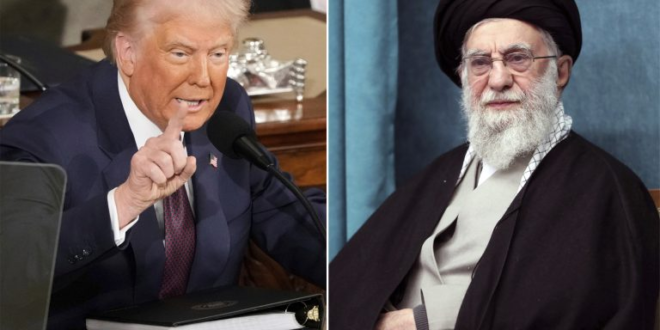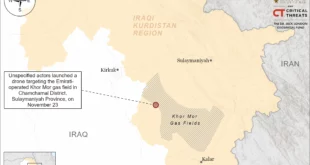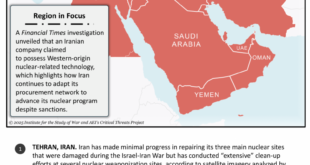- Trump is employing military action against Iran’s allies, and threatening strikes on Iran itself, to induce Iranian leaders to agree to new talks on limiting Iran’s nuclear program.
- Trump is balancing his intent to avoid sparking a new Middle East war with pressure from some of his aides and from Israel to immediately halt Iran’s nuclear program.
- Iran’s refusal to discuss limitations on its missile and drone programs or its support for regional armed factions, and its demands for extensive sanctions relief, will further complicate U.S.-Iran negotiations.
- Trump is seeking to use his renewed engagement with Russian President Vladimir Putin to increase pressure on Iran to begin talks.
U.S., Israeli, and European concerns over Iran’s advancing nuclear program have brought the Iran file to a top position on the Trump administration’s national security agenda. Iran’s nuclear advances are testing Trump’s long-stated intent to avoid sparking a significant new regional war. Iran’s nuclear program is assessed by the International Atomic Energy Agency (IAEA) as within weeks of assembling enough fissile material for six nuclear weapons, were there a decision to enrich to the 90 percent purity considered “weapons grade.” Trump’s concerns about a potential nuclear-armed Iran and his extensive support for Israeli Prime Minister Benjamin Netanyahu’s policies lead many to conclude that Trump might be considering Netanyahu‘s proposal that the U.S. and Israel jointly destroy Iranian nuclear facilities. Recognizing that Trump might decline U.S. participation, Israeli officials who are attending a “strategic meeting” in Washington this week on Iran’s nuclear program seek U.S. backing for a unilateral Israeli strike on Iranian facilities, even if doing so would be less effective than a joint strike.
Although he is reluctant to risk regional war by attacking Iran, Trump is demonstrating his willingness to use force in order to convince Iranian leaders their best option is to engage in negotiations with his administration. In an early March Fox Business interview, Trump revealed that he sent a letter to Iran’s Supreme Leader Ayatollah Ali Khamenei proposing direct negotiations. He paraphrased the contents as: “There are two ways Iran can be handled: militarily, or you make a deal.” In other interviews, Trump sought to reinforce pressure on the Iranian regime by saying the U.S. is “down to the final moments” with Iran and that “[w]e can’t let them have a nuclear weapon. Something is going to happen very soon. I would rather have a peace deal than the other option, but the other option will solve the problem.” Some accounts indicate the letter insisted Iran agree to U.S. terms for a nuclear agreement within two months, although it is not clear whether that deadline represents the time from delivery of the letter or from when negotiations begin.
Indicating Trump officials are willing to allow the Arab Gulf states more input into any new agreement with Iran than they had in reaching the multilateral 2015 agreement (JCPOA), the Trump letter was delivered by Middle East Special Envoy Steve Witkoff to the President of the United Arab Emirates (UAE) Mohammed Bin Zayed al-Nahyan (MBZ) in a meeting in Abu Dhabi. MBZ’s senior foreign policy aide, Anwar Gargash, then traveled to Tehran and gave the letter to Iranian Foreign Minister Abbas Araghchi. Some accounts indicate the Sultanate of Oman, which has the closest ties to Iran of any Gulf state and mediated the early talks that led to the 2015 JCPOA, is also seeking to bring Trump administration and Iranian officials together. Appearing to confirm that Gulf states are facilitating back-channel U.S.-Iran diplomacy, Araghchi recently affirmed that indirect talks through countries like Oman are “not a strange method,” and on Friday, he held a phone call with his Emirati counterpart.
In mid-March, Trump sought to erase Iranian skepticism that he is willing to use force against Iran if Tehran refuses talks. Trump ordered a campaign of strikes – still ongoing – against the Iran-backed Houthi movement (Ansarallah) in Yemen to deter it from resuming strikes on commercial shipping in the Red Sea. The strikes targeted not only missile and drone storage and launch facilities but also Houthi leaders in their geographic stronghold in Saada province and in the capital, Sanaa. Explaining the Yemen strikes, in large part, as a message to Iran to cease its support for regional armed factions, Trump posted on his Truth Social account: “To Iran: Support for the Houthi terrorists must end IMMEDIATELY! Do NOT threaten the American People, their President, who has received one of the largest mandates in Presidential History, or Worldwide shipping lanes. If you do, BEWARE, because America will hold you fully accountable.”
Still, experts assess that Trump’s strike on the Houthis might not necessarily intimidate Iranian leaders, who continue to question whether Trump is willing to attack Iran. The Supreme Leader initially rejected Trump’s letter outright, arguing he is untrustworthy as the president who exited the JCPOA in 2018, despite IAEA assessments Iran was complying with its terms. Khamenei later modified his objections to state Iran had no intention of succumbing to “bullying governments.” Yet, whether they believe Trump would use force, Iranian leaders nonetheless want to ease economic pressure from U.S.-led sanctions. The three leading European interlocutors with Iran – Germany, France, and the United Kingdom – plan to invoke a “snap back” of all UN sanctions on Iran. Under UN Security Council Resolution 2231, European leaders have until October 18, 2025, to trigger the snap-back before that capability expires. A snap-back would surely increase the economic strains on Iran from Trump’s re-imposition of his maximum pressure policy on Iran.
The prospects of a new nuclear agreement that would derail the UN sanctions snap back and relieve most U.S.-led secondary sanctions hold significant attraction for Iranian policymakers. Contradicting Khamenei’s rebuff of the Trump overtures, the Iranian mission to the United Nations issued a statement on “X” (formerly known as Twitter) that did not rule out negotiations, saying: “If the objective of negotiations is to address concerns vis-à-vis any potential militarization of Iran’s nuclear program, such discussions may be subject to consideration.” Foreign Minister Aragchi said Tehran was still evaluating the Trump letter and weighing its reply, adding: “Trump’s letter was more a threat, but it claims to have opportunities. We paid attention to all points held in the letter and will consider both threat and opportunity in our response…”
Trump’s diplomacy with President Vladimir Putin on a Ukraine war settlement adds to Tehran’s apparent review of its resistance to talking with Trump’s team. An official readout of a Trump-Putin phone call last Tuesday noted “the leaders spoke broadly about the Middle East as a region of potential cooperation to prevent future conflicts. They further discussed the need to stop proliferation of strategic weapons and will engage with others to ensure the broadest possible application. The two leaders shared the view that Iran should never be in a position to destroy Israel.” The Trump-Putin talks concern Tehran that its perceived strategic ally, Moscow, might abandon its support for Iran in the interests of renewed economic ties to the U.S. and reintegration into the global community.
Even if Trump’s strategy produces U.S.-Iran talks, reaching an agreement with Tehran will be difficult. Trump and his aides insist any new agreement cover all outstanding issues and address the weaknesses of the original JCPOA. Trump’s National Security Adviser Mike Waltz said last week that Iran needs to “hand over and give up” all elements of its nuclear program, including missiles, weaponization and enrichment of uranium. The Waltz statement indicates Trump is demanding Iran dismantle its entire uranium enrichment capabilities – a limitation that goes far beyond the terms of the JCPOA – as well as negotiate limits on its missile program. Other U.S. statements indicate Trump is also demanding limits to Iran’s armed drone program and end funding and arming Iran’s Axis of Resistance partners. Iran categorically refused to agree to restrain its regional activities in the JCPOA talks, and it is certain to again reject restrictions on those activities in a new deal. Iran also has vociferously rejected any agreement that requires it to end all uranium enrichment, arguing it has a “right” to do so under the Nuclear Non-Proliferation Treaty (NPT).
Another hurdle to a potential agreement is the Trump team’s likely unwillingness to provide Iran the degree of sanctions relief it will demand. Iranian leaders complained that they did not receive all the promised benefits of the JCPOA, and that any new deal would have to expand sanctions relaxation. Yet, Trump and his aides argued against the 2015 deal for providing Iran too much sanctions relief, and enabling Iran to amply fund its Axis of Resistance partners. On Thursday, Trump in fact added Iran sanctions to try to reduce the flow of Iranian oil to China. The Treasury Department sanctioned a refinery in east China’s Shandong Province and vessels that supplied oil to Chinese plants linked to the Houthis in Yemen. U.S. State Department spokesperson Tammy Bruce said the measures targeted so-called “Teapot refineries” – small, privately-owned operations in China that process Iranian crude – pursuant to Trump’s “maximum pressure” campaign to drive Iran’s oil exports, including to China, to zero.
 Eurasia Press & News
Eurasia Press & News



